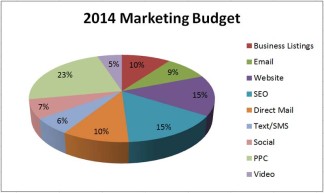 There’s really only one reason for a business to advertise and spend money on marketing: and that is to get leads/customers.
There’s really only one reason for a business to advertise and spend money on marketing: and that is to get leads/customers.
Depending on the kind of business you have, you may think of marketing as a way to establish relationships. Or if you’re involved in inbound marketing, you may think your main purpose is providing helpful information to your target audience. Though true and admirable, even the most altruistic motivations have a desired ultimate outcome: more leads.
Step One – Review 2013
- What worked for you in 2013?
- What didn’t work? Do you know why?
- What are the things you thought about trying, but didn’t?
- Was it the cost involved?
- The time involved?
- Or did you just not know enough about it?
Add up the dollars and the hours you spent on various types of advertising and marketing in 2013, and use that list to make a plan for 2014. If something didn’t work for you, are you sure you know why? For example, if you added a mobile website, but you don’t think it brought in any new business, be careful not to throw out the baby with the bath water. It could be that you just need to make the desired action more prominent and easier for mobile users. If you want them to call, don’t give them a form to fill out. Make sure your phone number is prominent and clickable. Consider using a trackable phone number on your mobile site so you know for sure how many calls it generates for you.
Whatever marketing tactics you used in 2013, there is sure to be a way to make them more effective. Don’t just clone your advertising plans from 2013 and call it a day. Refine what you did to make it more effective.
Step Two – Add One New Marketing Tactic
After analyzing how you did in 2013, choose a new marketing tactic to add for 2014. Perhaps you want to start a pay-per-click advertising program, or you decide to take the plunge and get into social media. Maybe you need to experiment with email campaigns or direct mail. Whatever it is, check what others in your industry are doing and find some inspiration to try a new (to you) way to increase leads.
Step Three – Add a Metric to Your Goals
Let’s say you decide to spend your 2014 budget on enhancing your business listing, adding content to your website, emailing specials and offers to your opted-in customer list, and focusing on using Facebook to engage customers and make your business visible on social media.
How will you know how well each of these marketing methods is working for you? For the ones you’ve used before, try to determine how well each method worked for you in 2013 and bump that up by at least 10%. So if your website sent you 50 new customers this past year, set your goal for 55 and then decide how you’re going to make that happen. What do you have to do to your website to make it more effective and bring you more more business?
Decide on what it is you want to measure (number of calls, number of online orders, number of coupons redeemed, etc.) and then be sure you have a way to measure. Then set a realistic goal for each activity.
Tip: The truth is that every new advertising activity is going to take a while to reach full effectiveness. Don’t think that if you spend money on SEO, for example, your phone will start ringing off the hook immediately. Everything you do will have a cumulative effect that should be visible over time. That being said, if you’ve given it your best shot, and a certain type of advertising just isn’t showing results, check with an expert to make sure you’re doing it right. If you are, and it’s still not working, shift your money and energy to a tactic that works for you.
Step Four – Don’t Set It and Forget It
Let’s say you decide to spend $500 a month on marketing your business. And you allocate that money to the various activities you’ve decided to employ in 2014. Keep an eye on how that money is working for you. Measure, evaluate and tweak as needed. Maybe you need to bump that up to $600. Maybe you need to shift spending from one activity into a different one.
You’re busy running your business, and that’s your primary activity, but make time to regularly check on your advertising and marketing so you can tweak it throughout the year.
Step Five – Hire a Professional
Whether it’s building a mobile website, increasing your direct mail advertising or setting up a business Facebook page, it is money well spent to hire professional help rather than trying to save money by doing it all yourself or trusting your business to inexperienced (though well-meaning) employees, friends or relatives.
But even if you hire a partner to help you with your marketing, everything will be more effective the more engaged YOU are in the process. Be available for your web designer, your PPC campaign manager, your social media manager. Make sure your vision and personality are represented. Every dollar you spend will provide more value if you make yourself accessible to the people you pay to help your business succeed.
Here’s to a fantastic 2014!




